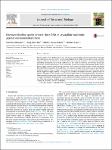Dormant Bacillus spores protect their DNA in crystalline nucleoids against environmental stress
Dittmann, Christin
Han, Hong-Mei
Grabenbauer, Markus
Laue, Michael
Bacterial spores of the genera Bacillus and Clostridium are extremely resistant against desiccation, heat and radiation and involved in the spread and pathogenicity of health relevant species such as Bacillus anthracis (anthrax) or Clostridium botulinum. While the resistance of spores is very well documented, underlying mechanisms are not fully understood. In this study we show, by cryo-electron microscopy of vitreous sections and particular resin thin section electron microscopy, that dormant Bacillus spores possess highly ordered crystalline core structures, which contain the DNA, but only if small acid soluble proteins (SASPs) are present. We found those core structures in spores of all Bacillus species investigated, including spores of anthrax. Similar core structures were detected in Geobacillus and Clostridium species which suggest that highly ordered, at least partially crystalline core regions represent a general feature of bacterial endospores. The crystalline core structures disintegrate in a period during spore germination, when resistance against most stresses is lost. Our results suggest that the DNA is tightly packed into a crystalline nucleoid by binding SASPs, which stabilizes DNA fibrils and protects them against modification. Thus, the crystalline nucleoid seems to be the structural and functional correlate for the remarkable stability of the DNA in bacterial endospores.
Files in this item
No license information

